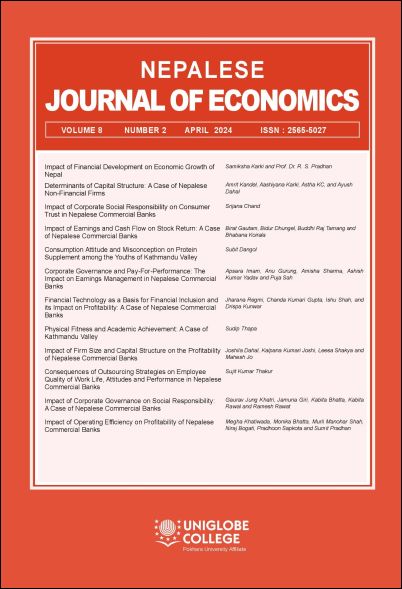Financial Technology as a Basis for Financial Inclusion and its Impact on Profitability: A Case of Nepalese Commercial Banks
DOI:
https://doi.org/10.3126/nje.v8i2.68807Keywords:
return on assets, return on equity, number of branches, credit to deposit ratio, deposit to assets ratio, credit to assets ratio, deprived sector lendingAbstract
This study examines the impact of financial technology as a basis for financial inclusion on the profitability of Nepalese commercial banks. Return on assets and return on equity are selected as the dependent variables. Similarly, number of ATMs, number of branches, debt to assets ratio, credit to assets ratio, credit to deposit ratio and deprived sector lending are selected as the independent variables. This study is based on secondary data of 16 commercial banks with 112 observations for the study period from 2015/16 to 2021/22. The data were collected from Banking and Financial statistics published by Nepal Rastra Bank, reports published by the Ministry of Finance, and annual reports of respective banks. The correlation coefficients and regression models are estimated to test the impact of financial technology on the profitability of Nepalese commercial banks.
The results showed that number of ATMs of a bank has a positive effect on return on assets and return on equity. This implies that increase in the number of ATMs of the bank leads to increase in return on assets and return on equity. Likewise, number of branches of a bank has a positive effect on return on assets and return on equity. This implies that increase in the number of branches of the bank leads to increase in the return on assets and return on equity. Similarly, debt to assets ratio has a positive effect on return on assets and return on equity. This indicates that higher the debt to assets ratio, higher would be the return on assets and return on equity. Likewise, credit to deposit ratio has a negative effect on return on assets and return on equity. This indicates that higher the credit to deposit ratio, lower would be the return on assets and return on equity. Similarly, credit to asset ratio has a negative effect on return on assets and return on equity. This indicates that higher the credit to asset ratio, lower would be the return on assets and return on equity. Furthermore, deprived sector lending has a negative effect on return on assets and return on equity. It implies that higher the deprived sector lending of a bank, lower would be the return on assets and return on equity.




